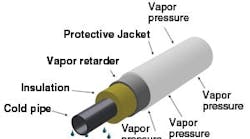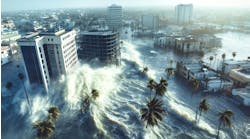As summer arrives and puts more stress on chilled water systems, proper insulation of these pipes will help you avoid massive failures. Unconditioned spaces in hot and humid climates are of particular concern, though these practices should be applied everywhere.
“Problems with moisture condensation and mold on pipe insulation are not just relegated to hot and humid climates, but the problems are more frequent and disastrous there,” says Gordon H. Hart, a consulting engineer with ARTEK Engineering, an engineering and subcontracting company. “It can be just as humid in Iowa as it is in Florida.”
In Miami, the cost of a chilled water system insulation job at an office building was $750,000, but Hart noted that the system failed before the facility was even occupied. Replacement cost around $25 million.
Failures start with design and can be aggravated by poor installation and maintenance, Hart explains.
Design
“I see poor selection of materials rather than poor-quality materials,” Hart says. “Designers fail to take into account that you’re going to get condensation on the surface at some point, so they need to specify materials that can get wet.”
Unconditioned spaces like mechanical rooms and covered garages are particularly vulnerable to water vapor and condensation. Avoid all-surface jackets with an exposed paper surface in these applications because they can get wet and grow mold.
“Once mold starts, it doesn’t go away. It attracts more moisture on its own, so a little bit of mold sponsors more mold. Bad quickly goes to worse,” Hart explains. “Water-resistant vapor retarders are essential. Some are plasticized.”
Design should also include properly sealed joints. Where the jacket of the insulation overlaps, adhesive or tape is used as joints to prevent water vapor permeation.
“Once water vapor gets inside the insulation, it condenses into water, and you have two problems," Hart says. "One is obvious: you have wet insulation to replace. The other is that the pipe starts to rust.” Both issues are expensive and disruptive.
Another necessary design aspect is the use of vapor dams where the end of the insulation is sealed to the pipe. They should be put in at fittings like elbows and T's, and every 20 feet on straight sections. If the jacket is punctured and water vapor can get into that area, vapor dams section it off so the problem can’t spread over the whole job.
Installation
“Once these things are specified properly, it’s incumbent on the installer to put them in correctly,” Hart says. “Attention to detail is critical.”
Hart recommends coating steel pipes with a corrosion-resistant paint, but many decision makers don’t want to spend the money.
Also make sure the installer isn’t attaching the vapor retarder with staples.
“Staples mean holes, and when you have holes, you have water vapor that will get in through them,” Hart explains.
Photograph the joints and vapor dams to verify that they’re done because they can’t be seen once covered. All contractors should be on the same page with the building owner so everyone is accountable.
Maintenance
“Accidents and damage do occur, but you want to repair it as quickly as possible,” Hart warns.
Building maintenance staffs aren’t insulation specialists, Hart grants, but they should carry a roll of high-performance insulation tape in case the system is gouged.
“I see a lot of cases where the jacket is punctured in mechanical rooms and it’s out of sight, out of mind. But it shouldn’t be out of sight for the maintenance staff,” he says.
For repairs in places where tape can’t be used, like odd-shaped barriers and fittings, Hart recommends having mastic on hand.
Walk the job and know the job, he suggests.
The moral of the story: it's cheaper to do everything right the first time.
“The owner has to stay on top of this, because nobody else will," Hart advises. "He needs to take pride in his system and recognize that if it gets compromised, it can lead to a huge disaster.”
Chris Curtland ([email protected]) is assistant editor of BUILDINGS.


